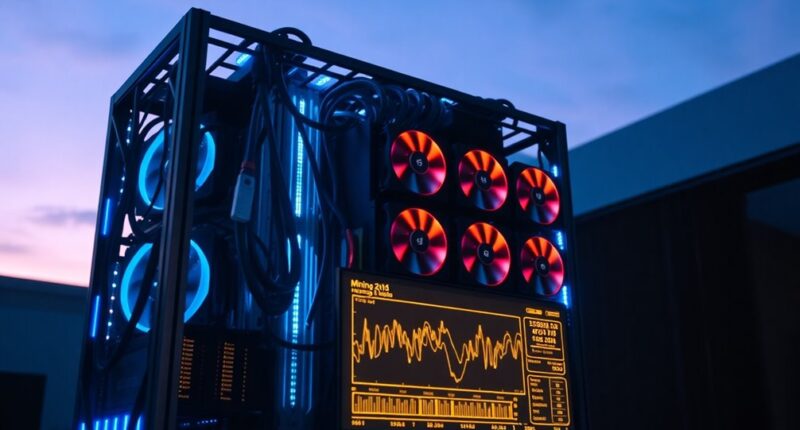Rig mining is the process where you use specialized hardware, called mining rigs, to tackle complex problems and validate transactions on blockchain networks, especially in cryptocurrencies like Bitcoin. These rigs can range from CPU and GPU setups to more advanced ASIC miners, each with its own efficiency and cost dynamics. You'll need various components, including a motherboard, power supply, and cooling systems, to run your rig effectively. Profitability hinges on factors like energy efficiency and market volatility. There's a lot more to explore about optimizing your mining operation and understanding the latest technologies in this field.
Key Takeaways
- Rig mining involves setting up specialized hardware to validate transactions and earn cryptocurrency rewards through computational power.
- Different types of mining rigs include CPU, GPU, ASIC, and FPGA, each offering varying efficiency and performance levels.
- Key components of a mining rig include a motherboard, power supply, cooling systems, storage, and a stable internet connection.
- Profitability in rig mining depends on factors like initial investment, energy efficiency, market volatility, and mining difficulty.
- Emerging technologies, such as advanced ASIC miners and modular rigs, enhance performance and adaptability in the evolving mining landscape.
Mining Rig Overview
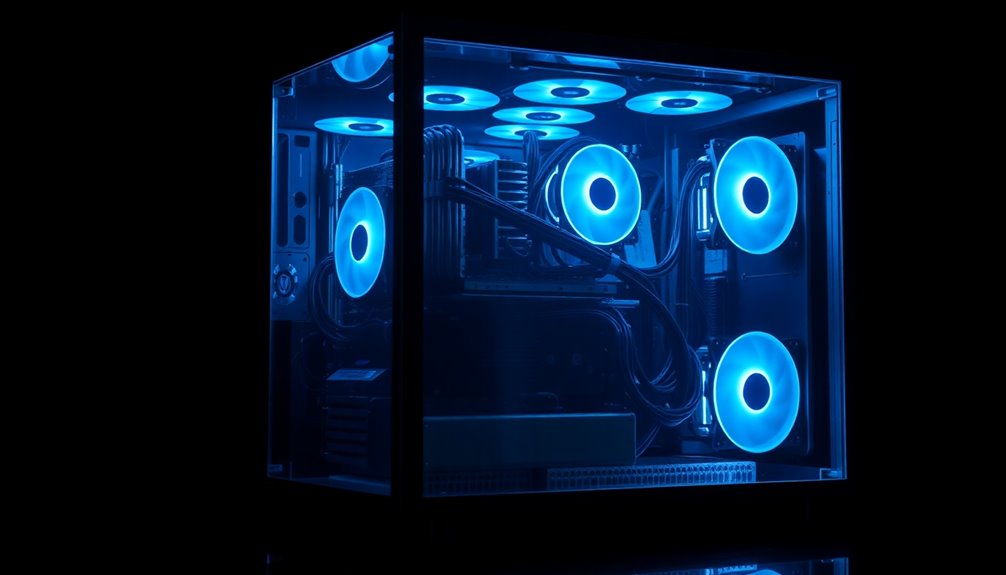
When you think about cryptocurrency mining, a mining rig is at the heart of the operation. This specialized computer system uses multiple graphics processing units (GPUs) to efficiently solve complex cryptographic equations and validate blockchain transactions.
Depending on the design, mining rigs can be categorized into CPU miners, GPU miners, ASIC miners, and FPGA miners. ASIC miners stand out for their incredible power and efficiency, especially in Bitcoin mining, achieving hash rates up to 100 terahashes per second (TH/s).
To set up a mining rig properly, you'll need essential components like a compatible motherboard, sufficient power supply, effective cooling systems, and storage for your operating system and mining software. This setup helps secure the cryptocurrency network while generating new coins.
Understanding Mining Rig Basics
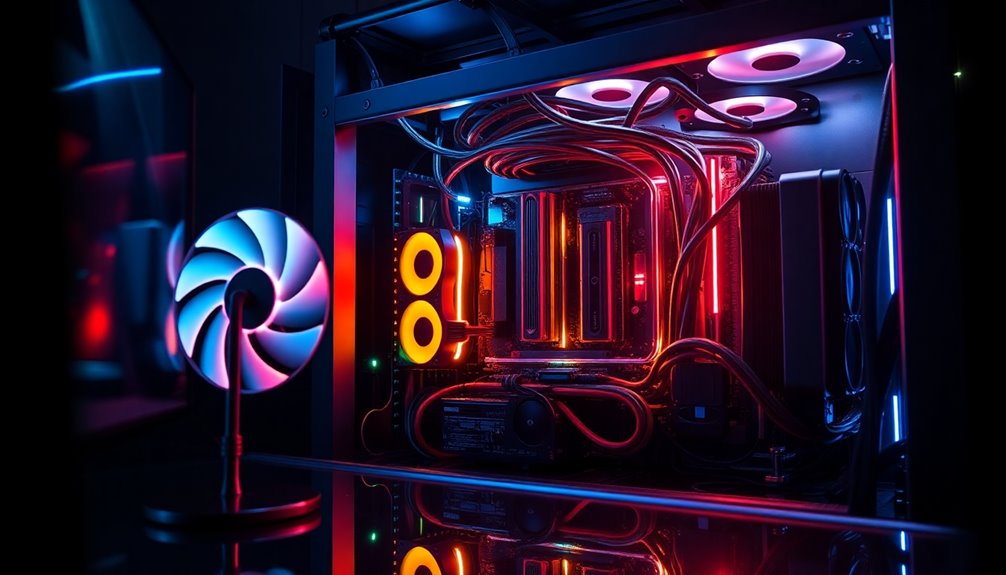
Mining rigs serve as the backbone of cryptocurrency operations, combining various hardware components to tackle the intricate challenges of blockchain validation.
A mining rig is a specialized system designed to mine cryptocurrencies by solving complex puzzles. You'll often encounter GPU mining rigs, which balance cost and performance, making them popular among miners.
On the other hand, ASIC miners are purpose-built for specific cryptocurrencies, especially Bitcoin, due to their high efficiency and energy savings.
Understanding the efficiency of your mining rig is vital; it's measured in energy expenditure per trillion hash functions (J/TH).
Hashing Algorithms Process Transactions
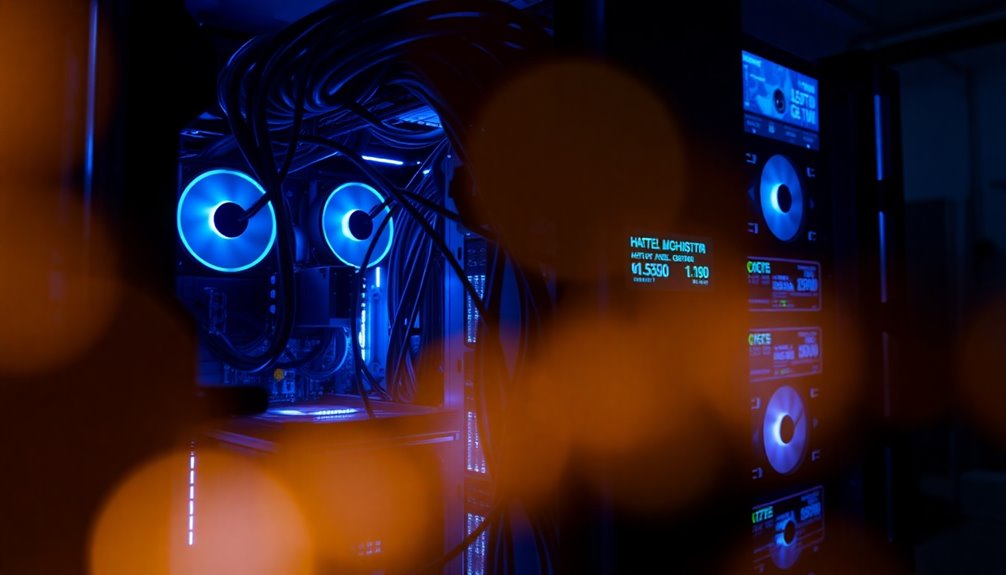
Hashing algorithms play a crucial role in processing transactions on blockchain networks, as they transform input data into a fixed-size string of characters that ensures transaction integrity.
In cryptocurrency mining, miners compete to solve complex mathematical puzzles tied to these hashing algorithms. For instance, Bitcoin uses SHA-256, while Ethereum initially relied on Ethash. The first miner to crack the puzzle adds a new block to the blockchain, earning rewards.
The difficulty of these puzzles adjusts roughly every two weeks, allowing for a steady block mining rate. Efficient hashing not only validates transactions but also impacts mining profitability; lower energy consumption per hash leads to a higher return on investment for mining operations, making it essential for miners to optimize their processes.
Pros and Cons of Mining

While the allure of earning cryptocurrency rewards can be enticing, participating in mining comes with its own set of advantages and disadvantages.
One of the main pros of mining is the potential to earn rewards while contributing to network security and transaction validation. If you invest in energy-efficient ASIC miners, you could enjoy lower energy costs, with some models achieving impressive performance metrics.
However, the initial investment in hardware can be substantial, ranging from $500 to $10,000, which can impact overall profitability. Additionally, market volatility can lead to fluctuating earnings, making it essential to carefully calculate your potential profits.
Lastly, don't overlook the environmental impact, as mining can consume as much energy as some small countries, raising sustainability concerns.
Mining Rig Performance Evaluation
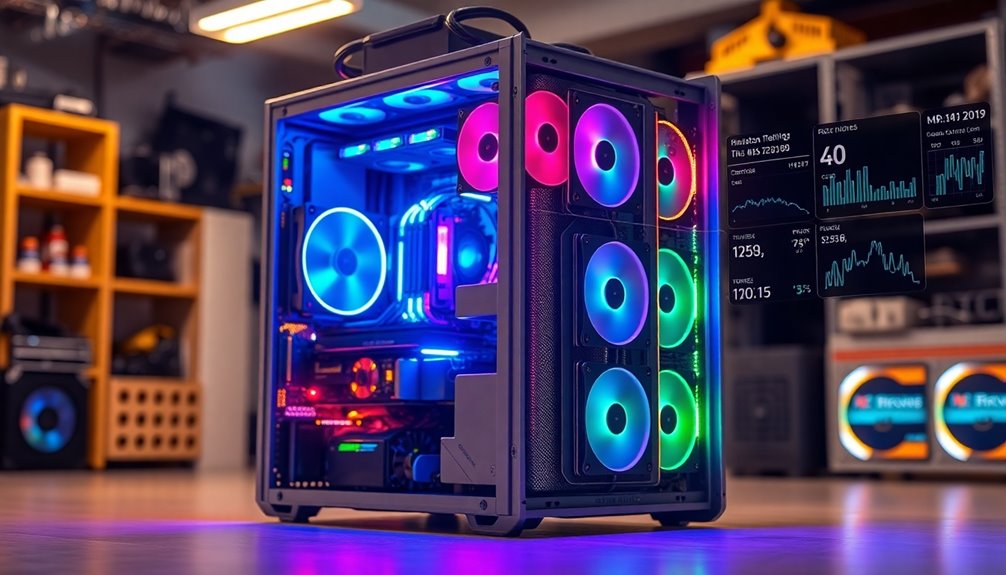
When evaluating the performance of a mining rig, several key metrics come into play that can significantly impact your overall success.
First, the hash rate is crucial; it measures how many hash functions your rig can compute per second, with higher values indicating better performance.
Energy efficiency is another vital metric, reflecting how much energy your rig consumes for each unit of hashing power, expressed in joules per terahash (J/TH). Lower values mean greater efficiency and cost savings.
Finally, don't overlook your cooling system's effectiveness. An efficient cooling solution, whether air or liquid, keeps your rig from overheating, preserving processing power and preventing hardware damage.
Balancing these factors ensures optimal performance and profitability in mining.
Market Volatility Impacts Profitability
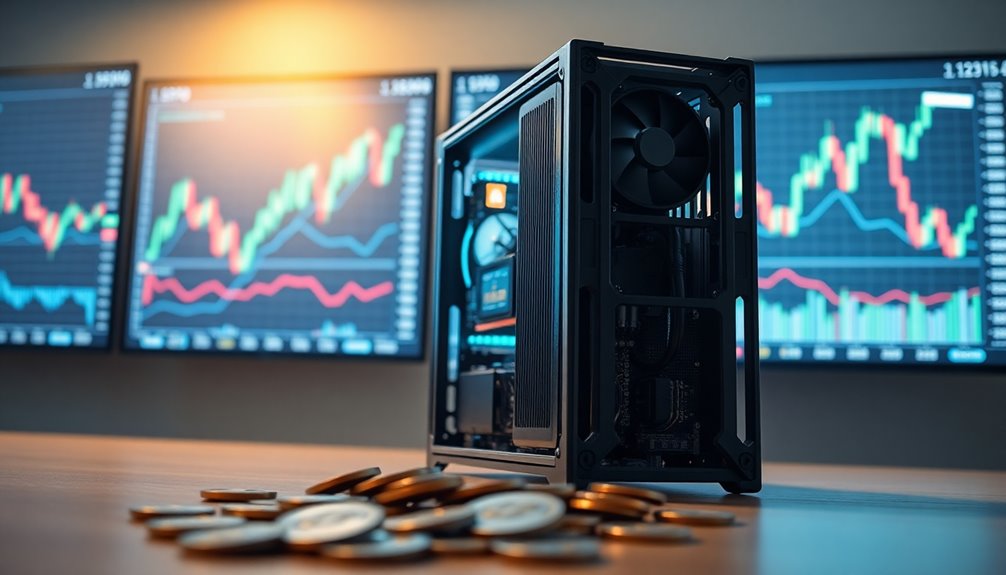
Market volatility plays a crucial role in determining your mining profitability, as fluctuations in cryptocurrency prices can significantly affect your earnings. A sharp decline in prices might reduce your returns, making it hard to cover essential operational costs like electricity and hardware maintenance.
You need to frequently assess market trends and adjust your mining operations accordingly; prolonged low prices can render mining unprofitable, particularly for less efficient rigs. Profitability calculations should include potential market fluctuations, since even a 10% drop in coin value can drastically decrease your income and return on investment (ROI).
If many miners exit due to downturns, the mining difficulty may lower temporarily, allowing you to earn more until the market stabilizes.
Emerging Mining Hardware Innovations
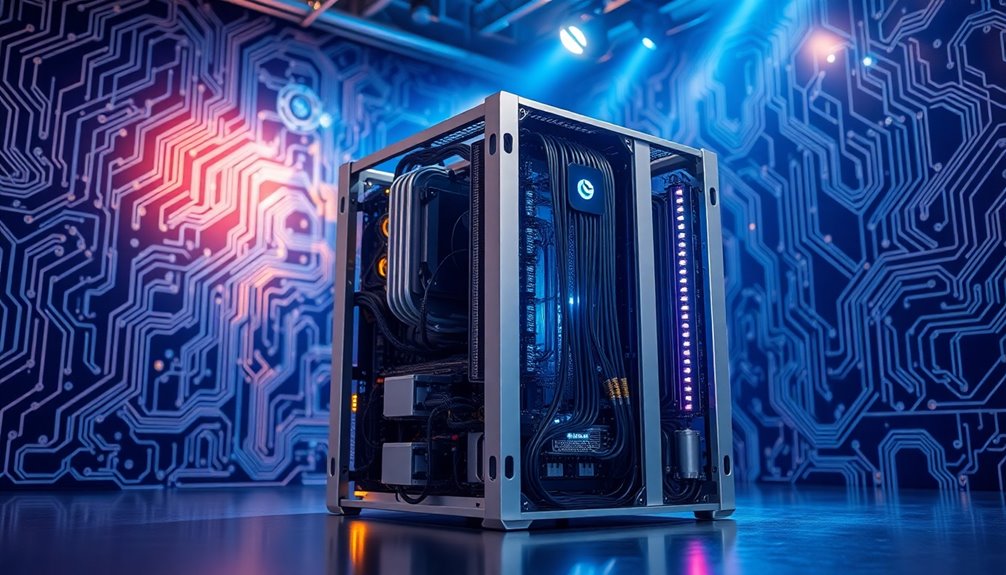
As mining technology evolves, staying updated on emerging mining hardware innovations is essential for maximizing your profitability.
Today's ASIC miners can reach impressive speeds of up to 100 terahashes per second while consuming less power than their predecessors, significantly boosting energy efficiency.
You might also consider FPGA miners, which offer flexibility to adapt to various algorithms, allowing you to switch between cryptocurrencies as the market fluctuates.
Recent advancements in chip manufacturing, particularly smaller transistor sizes, enhance both processing power and energy efficiency, making your mining operations more effective.
Additionally, modular mining rigs are emerging, allowing you to easily upgrade or replace components, ensuring your setup remains competitive in this ever-changing landscape.
Optimize Cooling Systems Effectively

To maintain optimal performance in your mining rig, effective cooling systems are crucial for preventing overheating, which can lead to hardware failure. Aim to keep your rig's temperature between 60-80°F (15-27°C) for peak efficiency.
Consider liquid cooling solutions, as they transfer heat away more effectively than air cooling. Additionally, utilize multiple fans strategically placed to improve airflow, ensuring hot air is expelled and cooler air is drawn in.
Regularly clean dust and debris from fans and heat sinks, as even minor buildups can reduce cooling efficiency by up to 30%.
Finally, monitor temperature and performance metrics through software to make real-time adjustments to fan speeds or cooling configurations, keeping your rig running smoothly.
Frequently Asked Questions
How Much Do Mining Rigs Make?
Mining rigs can make varying amounts depending on several factors. You might earn anywhere from a few hundred to several thousand dollars monthly, influenced by electricity costs, mining difficulty, and cryptocurrency prices.
If you use efficient ASIC miners, you could generate up to $15 daily in Bitcoin, while older GPU rigs may yield less than $5.
Just remember, operating costs can eat up a significant portion of your earnings.
How Long Does It Take to Mine 1 Bitcoin With One Rig?
Imagine you're racing against time, like Sisyphus pushing his boulder uphill.
Mining one Bitcoin with a single rig varies widely. If you've got a modern ASIC miner hitting around 100 TH/s, you're looking at roughly 10 days under current network difficulty.
But if your rig's hash rate is lower, it could take over 100 days.
Are Mining Rigs Still Profitable?
Yes, mining rigs can still be profitable, but it really depends on various factors.
You'll need to consider cryptocurrency prices, electricity costs, and mining difficulty, which can change often.
If you're using an ASIC miner, you'll likely see better efficiency and higher hash rates.
Joining a mining pool can also help you earn more consistently.
Just remember to evaluate your total costs to ensure your operation remains viable in the long run.
What Mining Rig Makes the Most Money?
When it comes to making the most money with mining rigs, you'll find that ASIC miners usually lead the pack.
With their impressive hash rates and energy efficiency, they can bring in substantial returns, especially if you score low electricity costs.
The Antminer S19 Pro stands out as a top choice, but keep in mind the importance of considering ongoing expenses.
Balancing initial costs with operational expenses is key to maximizing your profits.
Conclusion
In the world of cryptocurrency, diving into mining rigs is like stepping into a digital gold rush. You've got the chance to harness cutting-edge technology, but remember, it's not all sunshine and rainbows. The volatility of the market can make profits feel as elusive as a mirage in the desert. By staying informed and optimizing your setup, you can increase your odds of striking it rich. Just like the miners of old, perseverance and strategy are key to your success.
